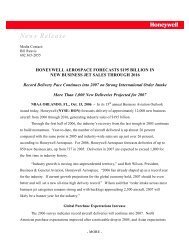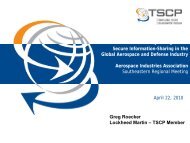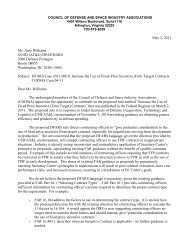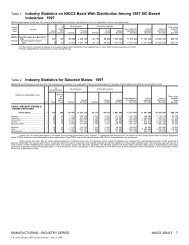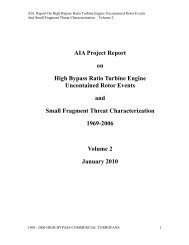Untitled - Aerospace Industries Association
Untitled - Aerospace Industries Association
Untitled - Aerospace Industries Association
Create successful ePaper yourself
Turn your PDF publications into a flip-book with our unique Google optimized e-Paper software.
Reusable Launch Vehicles2005 U.S. Commercial Space Transportation Developments and ConceptsThe K-1 employs off-the-shelf technology and Rocketplane XP – Rocketplane Limited, Inc.components in its design. The first stage, known asthe Launch Assist Platform (LAP), is powered by Vehicle: Rocketplane XPthree LOX/kerosene GenCorp Aerojet AJ26Developer: Rocketplane Limited, Inc.engines. These engines are U.S. modifications of First launch: 2007the fully developed, extensively tested core of the Number of stages: 1NK-33/NK-43 engines. These engines were originallydesigned for the Soviet lunar program in the (62.5 miles)Payload performance: 408 kg (900 lbs.) to 100 km1960s and subsequently placed in storage for overPlanned launch sites: Oklahoma Spaceport (primary)two decades. After launch, the LAP separates from and KSC (alternate)the second stage and restarts its center engine to put Targeted markets: Suborbital space tourism, microgravityresearch, small satellite deploymentthe stage on a return trajectory to a landing areanear the launch site. The LAP deploys parachutesand descends to the landing area where air bags aredeployed to cushion its landing. The second stage,or orbital vehicle, continues into LEO where itreleases its payload. A single Aerojet AJ26-60engine powers the orbital vehicle. Following payloadseparation, the orbital vehicle continues onRocketplane XPRocketplane Limited is developing the Rocketplaneorbit for approximately 24 hours. Then, aXP, a scaled-down version of its original PathfinderLOX/ethanol Orbital Maneuvering System performsa deorbit burn. Lastly, the orbital vehiclevehicle concept. The Rocketplane XP is a four-seatfighter-sized vehicle powered by two jet enginesends its ballistic reentry profile by deploying parachutesand air bags in a manner similar to the LAP.and one pressure-fed LOX/kerosene rocket engine,enabling it to reach altitudes of 107 kilometers (66miles). In 2004, Rocketplane Limited signed a marketingagreement with Incredible Adventures to sellKistler expects to operate the K-1 from twolaunch sites: Woomera, Australia, and a U.S. domesticlaunch site. Kistler Woomera Pty., Ltd., a whollysuborbital tourist flights. The company is currentlytaking reservations for Rocketplane flights andowned subsidiary of Kistler <strong>Aerospace</strong> Corporation,hopes to make its first tourist flight in 2007.will operate the K-1 from Woomera. Kistlerreceived authorization from the Australian governmentto begin construction of launch facilities atThe spaceflight experience as currently envisionedincludes 5 days of training and team socialWoomera in April 1998 and held a groundbreakingevents, with the spaceflight on the sixth day. Inceremony at the site several months later. Theaddition to space tourism flights, the company islaunch pad design is complete, and Kistler will conductits initial K-1 flights and commercial opera-pursuing other markets, including microgravityresearch and military applications, including smalltions from Woomera. In 1998, Kistler signed ansatellite deployment.agreement with the Nevada Test Site Development20Corporation to permit Kistler to occupy a segmentof the U.S. Department of Energy’s Nevada TestSite for its launch operations. The FAA/AST environmentalreview process was completed for theKistler project in 2002. In addition, Kistler continuesto explore potential U.S. launch and landingsites (subject to regulatory approval), such as atCCAFS, VAFB, and EAFB. In 2003, Kistler filed toreorganize under Chapter 11 of the U.S. BankruptcyCode, and it is in the final stages of the reorganizationprocess. Kistler plans to emerge from Chapter11 and restart the K-1 program in 2005. 1920 Federal Aviation Administration/Office of Commercial Space Transportation




